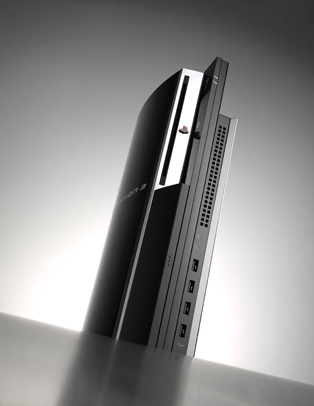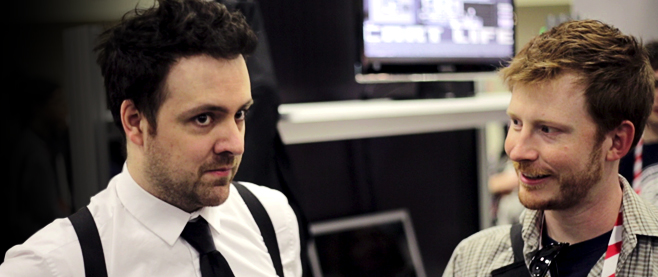To Swell the Ranks
Developing games for a console is hard, damn hard. Even with the ascent of indie developers over the last five years or so, the number of people who have the talent, time and other qualities needed to develop a game for a console is quite small, but the next generation of consoles might just change all that. As much as we all love Steam and PC gaming to death (and I do), there is still an audience, and a non-trivial one, who prefer their games on consoles. Frankly, the more ways a game is available to be played, the better.
A few weeks ago, Sony confirmed a bunch of rumours about the PlayStation 4. The response afterward was a mixture of thoughtful analysis (John Teti’s and Ian Bogost’s were especially erudite) and the usual sectarian bullshit that dominates discourse on the internet. What seemed to be missed though, or at least understated, was the simple fact Sony has possibly created the best videogame hardware the world has ever seen – if you’re a developer. They could be opening a door to people who previously would have had no hope of developing a console game.
[pullquote]Sony could be opening a door to people who previously would have had no hope of developing a console game.[/pullquote]
If the number of small console developers is going to increase, the community will need three things. First, hardware that’s easier to use and is easier to develop tools for. Second, a developer program with less expense and red tape between the developer and making their game available. Finally, a cultivated platform that showcases high-quality games and actively grows its audience.
In the first case, the PS4 is looking mighty nice. It is the first game-specific hardware that has an x86 CPU. That’s the same architecture that PCs have. That may sound like techno babble, but it’s actually very significant. Previously, most modern game consoles had PowerPC architectures, ranging from the relatively sane (Xbox 360’s Xenon) to the utterly barmy (PS3’s Cell). The Cell actually has a number of pseudo-microprocessors that all work in parallel. While potentially very powerful, actually working with that architecture is a giant pain in the ass and requires a good familiarity with the PS3’s quirks that can only be earned through blood, sweat and misery.
Apple also used to use this architecture in their desktops/laptops. But in 2006, they switched over to Intel-based x86 chips and it was A Big Deal. Suddenly, it was easier to make cross-platform Windows/Mac software (for a variety of reasons, including not having to resolve endianness and getting more compatible libraries). Sony moving the PS4 to an x86 architecture also has the possibility to be A Big Deal.
 The PS4 also has 8 GB of RAM. Again, this doesn’t seem like a big deal, until you consider that the PS3 and 360 only have 512 MB of RAM – that’s the same as an iPad 2 – and on the PS3 it’s actually split between 256 MB of system memory and 256 MB of video memory. And while we all know David Cage is full of it when he says we need better hardware to create real emotional reactions in games, it’s also true that the actual boots-on-the-ground practice of making games is needlessly more difficult under these technical limitations.
The PS4 also has 8 GB of RAM. Again, this doesn’t seem like a big deal, until you consider that the PS3 and 360 only have 512 MB of RAM – that’s the same as an iPad 2 – and on the PS3 it’s actually split between 256 MB of system memory and 256 MB of video memory. And while we all know David Cage is full of it when he says we need better hardware to create real emotional reactions in games, it’s also true that the actual boots-on-the-ground practice of making games is needlessly more difficult under these technical limitations.
This hardware could lower barriers to entry for developers. It could mean better, more cross-platform tools and a larger community of developers. That means more practitioners, more voices, more interesting design ideas and ultimately, better games.
Over at Kotaku, Jason Schreier contended “If you think good graphics make characters worth caring about, you’re probably insane.” Jason is absolutely right in that claim, but in citing Cart Life and To the Moon as examples of games with low technical requirements that are incredibly affecting (and without question, they are), he inadvertently demonstrates how impactful Sony’s decision could be.
When asked about his background in making games, Cart Life‘s creator Richard Hofmeier said, “You know, I don’t have any background in games to speak of. The tools and scripting languages have become so easy to use that somebody like me could just pick them up and go.” He used Adventure Game Studio, a PC-only toolset. To the Moon was developed using RPG Maker, another PC-only tool. The openness and simplicity of the PC as a development platform means tools like this are common and they’re supported by scads of tutorials and active developer communities. Currently, games created by these tools cannot run on the consoles. Even Unity, despite claims that it supports consoles, has been used for only a single game – Rochard – for the PS3. If the PS4 is as simple and open as Sony is claiming, maybe that would change.
Now, I prefer to play games on my PC, without question. I own less than a dozen 360/PS3 titles combined, versus well over 200 games on Steam (and yes, I’ve played most of them – I didn’t just get them through the bounty of Steam sales). But in developing Mark of the Ninja, I discovered there are plenty of people that prefer consoles. Maybe their only computer is a laptop with an integrated Intel video adapter that won’t play any game made after 2004. Maybe they just prefer the comfort of the couch. As expensive as a console may be, it’s certainly much cheaper than a new laptop and doesn’t require the knowledge needed to build a functioning desktop. I’m not into prescribing where people should play their games. The more platforms a game can be made available upon, without tremendous burden to the developer, the better.
 Ease of development isn’t the only barrier to making a game available for a console. To be a PC developer, all you need is a PC and since you’re writing your code on it, that takes care of itself. Console development requires specialized hardware. To date, it has required a modified console called a “devkit.” Devkits are absurdly expensive. Easily 100 times (seriously) what the consumer version of the console costs, if not more. That’s a year or two of living expenses for a developer. Some companies even require you to have an office, i.e. you must prove that you’re renting/own a space of at least a certain square footage at an address that is zoned commercially in your city, before they’ll even consider selling you a devkit.
Ease of development isn’t the only barrier to making a game available for a console. To be a PC developer, all you need is a PC and since you’re writing your code on it, that takes care of itself. Console development requires specialized hardware. To date, it has required a modified console called a “devkit.” Devkits are absurdly expensive. Easily 100 times (seriously) what the consumer version of the console costs, if not more. That’s a year or two of living expenses for a developer. Some companies even require you to have an office, i.e. you must prove that you’re renting/own a space of at least a certain square footage at an address that is zoned commercially in your city, before they’ll even consider selling you a devkit.
Back in the day when only massive corporations made games, this made sense. EA can afford dozens of devkits and can handle the acquisition thereof for any 3rd party developer making a game they’re publishing. Now that amazing games can be made by tiny teams working at home, the requirement of a devkit is tremendously prohibitive. If the only hardware needed to develop a PS4 game is a PS4 (and a PC, of course), it’s little different from developing for an iOS device. Now I haven’t seen a confirmation of this for the PS4, but Vita development only requires a $99 fee (same as Apple’s developer program), and hopefully this trend continues to the PS4.
That’s just getting the hardware. There’s all kinds of other complications to actually put a downloadable game on a console, most of which are similarly held over from the days when only gigantic publishers made games. Technically, all games released on a console need a publisher. Either you’re being published by the platform holder or by a 3rd party. To date, there are only a finite number of “slots” available for games on the service, which you’ll be jockeying for. All you can do is pray you don’t get assigned to the slot that coincides with the day the latest Call of Duty gets released. You can’t control the price of your game to run sales or promotions. Then there’s certification requirements, challenges updating your game, etc. that we’ve heard more about in the news over the last year or so. In short, getting your game to a place where people can give you money for it has way more barriers than just being a talented developer with a good idea. These complications are a matt er of policy, not technology. Changing them is simply a matter of someone having the will to do so.
er of policy, not technology. Changing them is simply a matter of someone having the will to do so.
Having reasonable hardware and simple development process is necessary to create a more open, robust community of developers, but not sufficient. There’s one more piece in the puzzle and that is good stewardship of the platform. In contrast, one can look at Microsoft’s Xbox Live Indie Games (XBLIG) platform. Games for XBLIG could be developed on retail Xbox hardware using XNA. While XNA isn’t quite as off-the-shelf as something like Unity or AGS, it was still really good. Andy Schatz built the Monaco prototype that won him the IGF grand prize in six weeks using XNA. Putting your game on XBLIG required no fees and no slots, just a simple form of peer review. And while that peer review process wasn’t flawless, it was far simpler than getting a game on XBLA.
So with this freedom and simplicity, what did people build for XBLIG? Looking at the service, the answer seems to be low-rent Minecraft knockoffs and “massage games.” There were a few interesting games on the service and the Indie Games Uprising – a creator driven awareness event/sale – attempted to draw attention to them, but the overwhelming majority of games on the service are extremely poor in quality.
Could it have ever been anything but? It’s hard to say. XBLIG was clearly a third class citizen on the Xbox, with discovery and visibility of the games being extremely challenging on top of the already onerous Xbox storefront/adwall.
A healthy platform requires stewardship and cultivation. The platform holder has a tremendous amount of influence of what gets noticed and how that sets the expectations of the audience on the platform. And again, Sony has been quite progressive in this regard. It’s hard to look at last year’s PSN lineup – Journey, Sound Shapes, The Unfinished Swan, Tokyo Jungle, Papo & Yo, et al. – and not be impressed at the diversity therein. And with The Witness being one of the few beacons of originality among the games shown at the PS4 event, it’s hopefully a trend they want to continue. And it seems I’m not the only one seeing it this way.
 Some people claim the future of games is mobile, but Apple has been pretty explicit about their (dis)interest in cultivating worthwhile cultural works on their platform. Beyond the depressing state of what is financially successful on that platform (slot machine apps that “customers” pay into but the machines never pay out? Vegas pit bosses must be green with envy!), Apple is 100% clear that they believe that games are a lesser form of culture than even the most banal pop music. From their App Store submission guidelines, “We view Apps different than books or songs, which we do not curate. If you want to criticize a religion, write a book. If you want to describe sex, write a book or a song, or create a medical app.” Apple essentially has implemented their own Hayes Code for games. While certainly people can create games of excellence and substance on iOS, this attitude contributes to how people see the platform and how rare it is to find iOS games that aspire to actually be about anything.
Some people claim the future of games is mobile, but Apple has been pretty explicit about their (dis)interest in cultivating worthwhile cultural works on their platform. Beyond the depressing state of what is financially successful on that platform (slot machine apps that “customers” pay into but the machines never pay out? Vegas pit bosses must be green with envy!), Apple is 100% clear that they believe that games are a lesser form of culture than even the most banal pop music. From their App Store submission guidelines, “We view Apps different than books or songs, which we do not curate. If you want to criticize a religion, write a book. If you want to describe sex, write a book or a song, or create a medical app.” Apple essentially has implemented their own Hayes Code for games. While certainly people can create games of excellence and substance on iOS, this attitude contributes to how people see the platform and how rare it is to find iOS games that aspire to actually be about anything.
Now, despite everything I’ve said, don’t look at this as some “defense” of Sony – see my distaste for sectarian bullshit. Nothing has really been done yet; saying words on a stage at a press conference means little. We’ll have to wait and see how close the claims are to reality, but I’m the kind of person for whom hope always springs eternal. If Sony’s decisions with regard to the PS4 mean there are more ways to create more interesting and diverse games, and if it’s easier for the people making those games to sustain themselves doing so, that’s a win for everyone. We can look at the games demonstrated at the event and be lament most of their sameness. The pounding engine that drives yet another dubstep-laden manshoot might also be the podium for another Jenova Chen, another Vander Caballero. If the PS4, or any console, is dedicated to lower the barriers to entry with sane hardware, easier access and healthy, cultivated platform, that is something to be genuinely excited about.
———
Nels Anderson is the lead designer for Mark of the Ninja. Follow him on Twitter @Nelsormensch.



